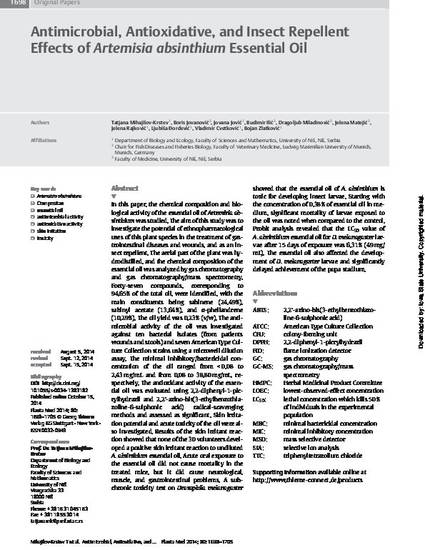
Article
Antimicrobial, Antioxidative, and Insect Repellent Effects of Artemisia absinthium Essential Oil
Planta Medica
(2014)
Abstract
In this paper, the chemical composition and biological activity of the essential oil of Artemisia absinthium was studied. The aim of this study was to investigate the potential of ethnopharmacological uses of this plant species in the treatment of gastrointestinal diseases and wounds, and as an insect repellent. The aerial part of the plant was hydrodistilled, and the chemical composition of the essential oil was analyzed by gas chromatography and gas chromatography/mass spectrometry. Forty-seven compounds, corresponding to 94.65 % of the total oil, were identified, with the main constituents being sabinene (24.49 %), sabinyl acetate (13.64 %), and α-phellandrene (10.29 %). The oil yield was 0.23 % (v/w). The antimicrobial activity of the oil was investigated against ten bacterial isolates (from patients wounds and stools) and seven American Type Culture Collection strains using a microwell dilution assay. The minimal inhibitory/bactericidal concentration of the oil ranged from < 0.08 to 2.43 mg/mL and from 0.08 to 38.80 mg/mL, respectively. The antioxidant activity of the essential oil was evaluated using 2,2-diphenyl-1-picrylhydrazil and 2,2′-azino-bis(3-ethylbenzothiazoline-6-sulphonic acid) radical-scavenging methods and assessed as significant. Skin irritation potential and acute toxicity of the oil were also investigated. Results of the skin irritant reaction showed that none of the 30 volunteers developed a positive skin irritant reaction to undiluted A. absinthium essential oil. Acute oral exposure to the essential oil did not cause mortality in the treated mice, but it did cause neurological, muscle, and gastrointestinal problems. A subchronic toxicity test on Drosophila melanogaster showed that the essential oil of A. absinthium is toxic for developing insect larvae. Starting with the concentration of 0.38 % of essential oil in medium, significant mortality of larvae exposed to the oil was noted when compared to the control. Probit analysis revealed that the LC50 value of A. absinthium essential oil for D. melanogaster larvae after 15 days of exposure was 6.31 % (49 mg/mL). The essential oil also affected the development of D. melanogaster larvae and significantly delayed achievement of the pupa stadium.
Keywords
- Artemisia absinthium,
- Compositae,
- essential oil,
- antimicrobial activity,
- antioxidative activity,
- skin irritation,
- toxicity
Publication Date
2014
DOI
10.1055/s-0034-1383182
Publisher Statement
© 2014 Georg Thieme
Citation Information
Tatjana Mihajilov-Krstev, Boris Jovanović, Jovana Jović, Budimir Ilić, et al.. "Antimicrobial, Antioxidative, and Insect Repellent Effects of Artemisia absinthium Essential Oil" Planta Medica Vol. 80 Iss. 18 (2014) p. 1698 - 1705 Available at: http://works.bepress.com/boris-jovanovic/9/
